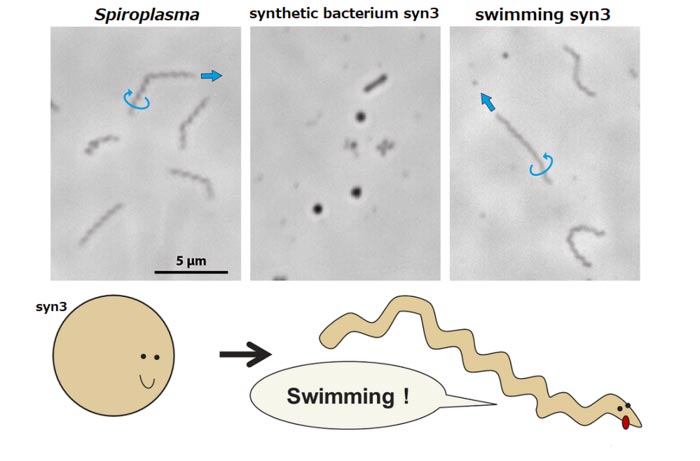Smallest mobile lifeform created

Osaka Metropolitan University researchers have made the mobile lifeforms that have the smallest genome so far. They introduced seven proteins, thought to let Spiroplama bacteria swim by spiraling, into a strain of synthetic bacteria. The small spherical synthetic bacteria have minimal genetic information, allowing them only to grow and divide. With the expression of these additional proteins, the synthetic bacteria formed helices and were capable of swimming, making them the smallest mobile lifeforms genetically.
Credit: Makoto Miyata, Osaka Metropolitan University
Understanding of cell motility’s evolution swims forward!
The origin of all biological movements, including walking, swimming, or flying, can be traced back to cellular movements; however, little is known about how cell motility arose in evolution.
A research team led by graduate student Hana Kiyama, from the Graduate School of Science at Osaka City University, and Professor Makoto Miyata, from the Graduate School of Science at Osaka Metropolitan University, introduced seven proteins, believed to be directly involved in allowing Spiroplasma bacteria to swim into a synthetic bacterium named syn3—through genetic engineering. syn3 was designed and chemically synthesized to have the smallest genomic DNA possible including the minimum essential genetic information required for growth from the smallest genomes of naturally occurring Mycoplasma bacteria.
“Studying the world’s smallest bacterium with the smallest functional motor apparatus could be used to develop movement for cell-mimicking microrobots or protein-based motors,” said Professor Miyata.
This genetically re-engineered syn3 changed from its normal spherical shape into a spiraling helix, which was able to swim by reversing the helix’s direction just like Spiroplasma. Further investigation revealed that only two of these newly added proteins were required to make syn3 capable of minimal swimming.
“Our swimming syn3 can be said to be the ‘smallest mobile lifeform’ with the ability to move on its own,” said Professor Miyata. “The results of this research are expected to advance how we understand the evolution and origins of cell motility.”
Watch the video explaining the study at https://youtu.be/VAY71FemC24.
About OMU
Osaka Metropolitan University is a new public university established by a merger between Osaka City University and Osaka Prefecture University in April 2022. For more science news, see https://www.upc-osaka.ac.jp/new-univ/en-research/, and follow us @OsakaMetUniv_en, or find us on Facebook.
Journal: Science Advances
DOI: 10.1126/sciadv.abo7490
Method of Research: Experimental study
Subject of Research: Cells
Article Title: Reconstitution of a minimal motility system based on Spiroplasma swimming by two bacterial actins in a synthetic minimal bacterium
Article Publication Date: 30-Nov-2022
Media Contact
Jens Herzog
Osaka Metropolitan University
koho-ipro@ml.omu.ac.jp
All latest news from the category: Life Sciences and Chemistry
Articles and reports from the Life Sciences and chemistry area deal with applied and basic research into modern biology, chemistry and human medicine.
Valuable information can be found on a range of life sciences fields including bacteriology, biochemistry, bionics, bioinformatics, biophysics, biotechnology, genetics, geobotany, human biology, marine biology, microbiology, molecular biology, cellular biology, zoology, bioinorganic chemistry, microchemistry and environmental chemistry.
Newest articles

Innovative 3D printed scaffolds offer new hope for bone healing
Researchers at the Institute for Bioengineering of Catalonia have developed novel 3D printed PLA-CaP scaffolds that promote blood vessel formation, ensuring better healing and regeneration of bone tissue. Bone is…

The surprising role of gut infection in Alzheimer’s disease
ASU- and Banner Alzheimer’s Institute-led study implicates link between a common virus and the disease, which travels from the gut to the brain and may be a target for antiviral…

Molecular gardening: New enzymes discovered for protein modification pruning
How deubiquitinases USP53 and USP54 cleave long polyubiquitin chains and how the former is linked to liver disease in children. Deubiquitinases (DUBs) are enzymes used by cells to trim protein…



